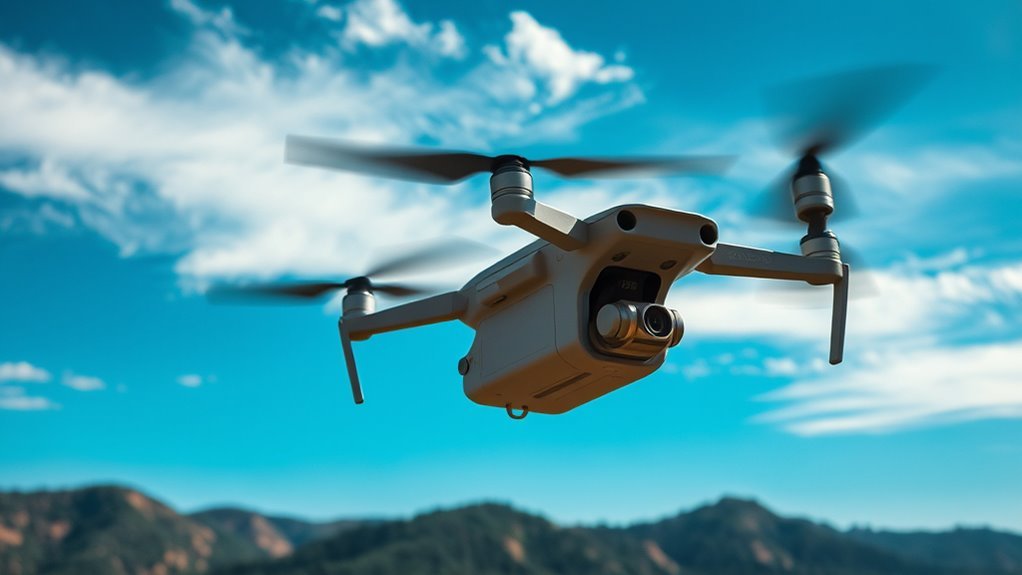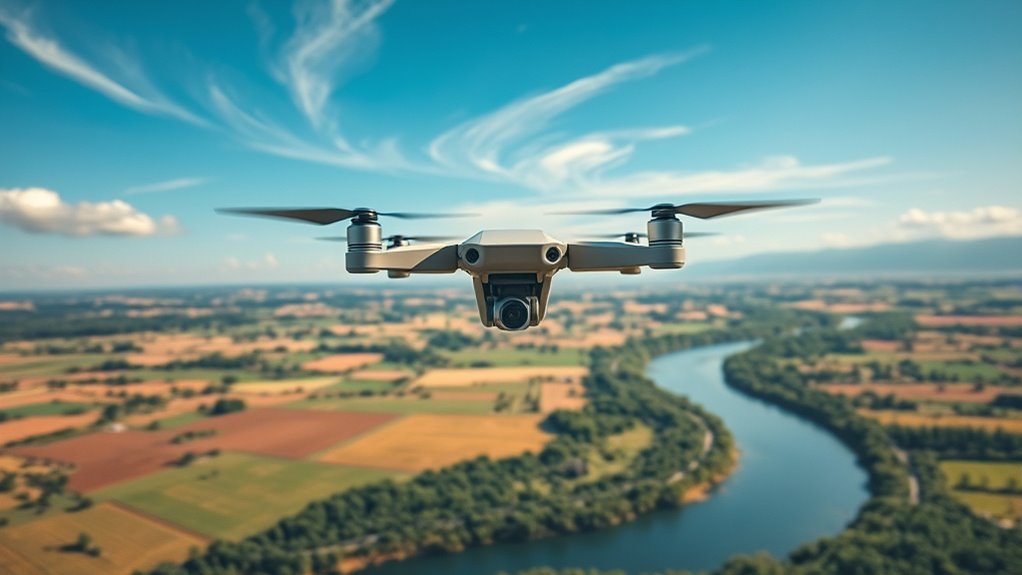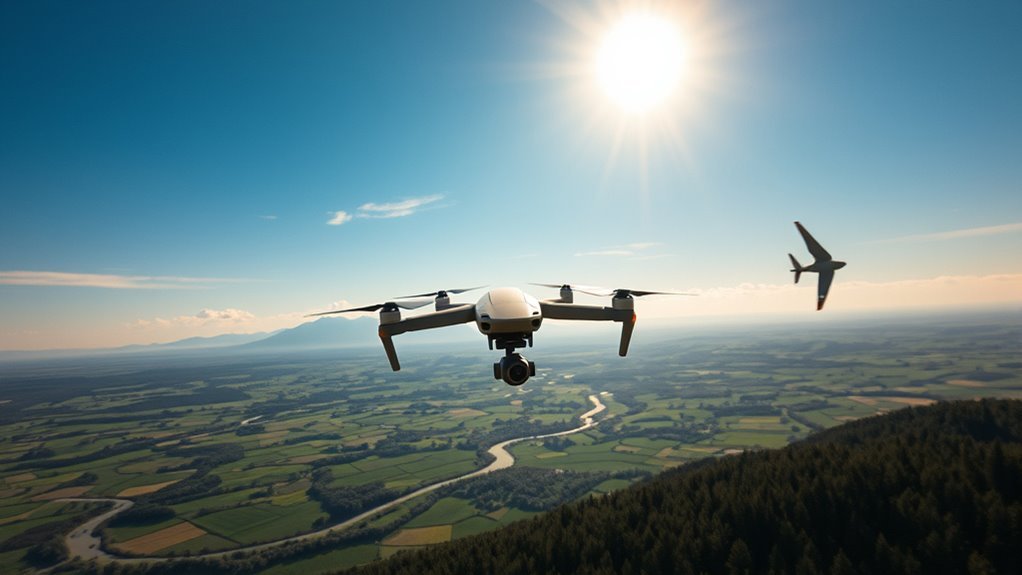Several key factors affect how far you can fly a drone. Battery life and capacity play a major role, as higher-capacity batteries extend flight time. Environmental conditions, like wind and temperature, can either enhance or hinder your range. The drone’s specifications, including weight and aerodynamics, also influence performance. Additionally, regulatory restrictions may limit where and how high you can fly. Finally, your skill level impacts control and maneuverability, which can greatly extend your flight distance. You’ll find more insights below.
Battery Life and Capacity

Although many factors influence a drone’s flight distance, battery life and capacity are among the most critical. You need to understand that advancements in battery technology directly impact your drone’s performance. Higher-capacity batteries typically allow for longer flight times, enabling you to explore greater distances. However, keep in mind that the weight distribution of your drone plays a significant role as well. An improperly balanced drone can lead to increased energy consumption, reducing overall flight distance. By optimizing the weight distribution, you can maximize the efficiency of your battery. Consequently, when selecting a drone, consider both the battery’s capacity and how its weight interacts with the drone’s design to achieve the freedom and range you desire. Additionally, understanding battery capacity differences can help you select the appropriate drone type for your needs. Moreover, payload management is crucial in ensuring that your drone operates efficiently and maintains stability during flight.
Environmental Conditions

While many drone enthusiasts focus on technical specifications, environmental conditions can greatly impact flight distance. Weather patterns, such as wind speed and direction, play an essential role. Strong winds can either hinder or assist your drone’s flight, affecting how far it can travel. Additionally, altitude effects become significant as drones operate at varying elevations. Higher altitudes often lead to thinner air, which can reduce lift and battery efficiency. Temperature also affects battery performance; colder conditions can reduce battery life, limiting your flying range. Understanding these factors enables you to better plan your flight path, ensuring you maximize your drone’s capabilities while adapting to the ever-changing environment. Staying informed about these conditions can truly enhance your flying experience. For instance, the longest flight time of drones like the DJI Mavic 3 Pro and Autel Robotics EVO Lite showcases how battery efficiency can be optimized under ideal conditions. Moreover, wind conditions significantly impact power consumption and stability, highlighting the importance of considering weather when planning your flights.
Drone Specifications

Drone specifications are essential for understanding a drone’s performance and capabilities, especially when it comes to flight distance. The drone weight plays a critical role; lighter drones can generally fly farther due to reduced energy consumption. Conversely, heavier models may struggle with battery life, limiting their range. Additionally, the camera type affects weight and aerodynamics. High-quality cameras add significant weight, which can diminish flight efficiency and overall distance. The balance between payload and battery capacity is important; if you prioritize advanced imaging, you might sacrifice range. Understanding these specifications allows you to make informed decisions, ensuring your drone fits your needs for both performance and freedom in the skies. Moreover, weight capacity constraints can heavily influence a drone’s operational range, as exceeding limits can lead to increased energy consumption and reduced flight time. Proper weight distribution also plays a crucial role in optimizing motor efficiency, which can further enhance your drone’s flight capabilities.
Regulatory Restrictions
Understanding drone specifications is only part of the equation; regulatory restrictions can greatly impact flight distance. You need to be aware of airspace classifications, as they dictate where you can fly. Different classes, such as controlled and uncontrolled airspace, come with specific rules that can limit your drone’s range. Legal compliance is vital; flying in restricted areas could result in hefty fines or worse. Additionally, altitude restrictions might prevent you from utilizing your drone’s full capabilities. Always check local regulations before planning your flight to guarantee you’re staying within the law. Drones must be flown only in designated areas in national forests, which adds another layer of complexity to your flight planning. Ignoring these factors could curtail your freedom to explore the skies effectively, so stay informed and compliant to maximize your drone’s potential. Visual line of sight must also be maintained to ensure safe navigation and compliance with legal standards.
Pilot Skill and Experience
Pilot skill and experience are critical factors that can greatly influence the distance a drone can effectively cover. Your proficiency in pilot training and flight techniques can make a significant difference in maximizing flight range.
| Skill Level | Impact on Distance |
|---|---|
| Beginner | Limited range due to poor control |
| Intermediate | Moderate range with improved stability |
| Advanced | Extended range through optimized maneuvers |
| Expert | Maximum range by utilizing advanced techniques |
As you hone your skills, you’ll learn to manage battery usage, navigate obstacles, and adapt to environmental conditions, all of which contribute to enhancing your drone’s flight distance. Emphasizing continual learning in pilot training will empower you to explore the skies with greater freedom.
Frequently Asked Questions
How Does the Drone’s Weight Impact Its Flight Distance?
The drone’s weight greatly impacts flight distance. Proper weight distribution in the drone design guarantees ideal aerodynamics, enabling longer flights. If it’s too heavy or unevenly distributed, you’ll find your range decreases markedly.
Can Payloads Affect a Drone’s Flying Range?
Yes, payloads can greatly affect your drone’s flying range. Proper weight distribution is essential; exceeding payload capacity reduces efficiency and battery life, limiting distance. Balancing weight guarantees peak performance, allowing greater freedom in flight.
Do Different Battery Types Alter Flight Distance Capabilities?
Just like a bird choosing its nest, the type of battery you select greatly influences your drone’s flight distance. Battery chemistry impacts power efficiency, ultimately determining how far you can soar on your adventures.
How Does GPS Accuracy Influence Drone Range?
GPS signal strength directly impacts navigation accuracy, affecting how far you can effectively fly your drone. Weak signals can lead to reduced range and erratic flight paths, limiting your operational freedom and overall effectiveness.
Are There Software Updates That Can Improve Flight Distance?
Imagine your drone as a bird, soaring higher with each firmware enhancement. Software updates often include range optimization features, allowing you to maximize flight distance, ensuring your aerial adventures are as expansive and liberating as possible.

